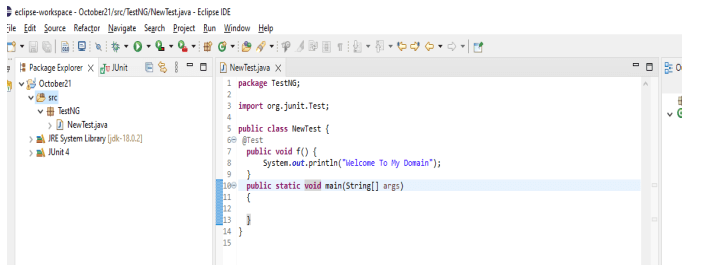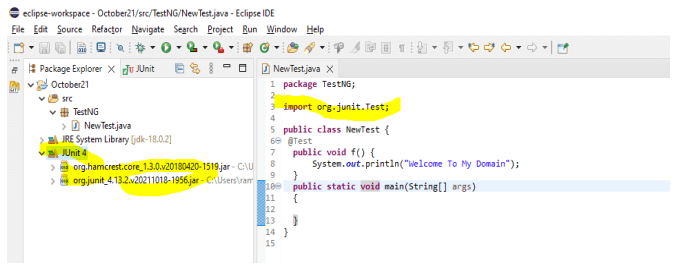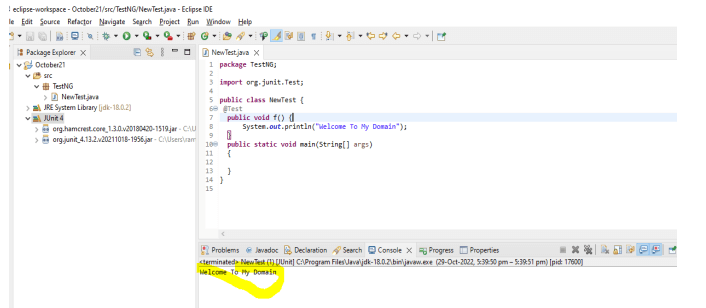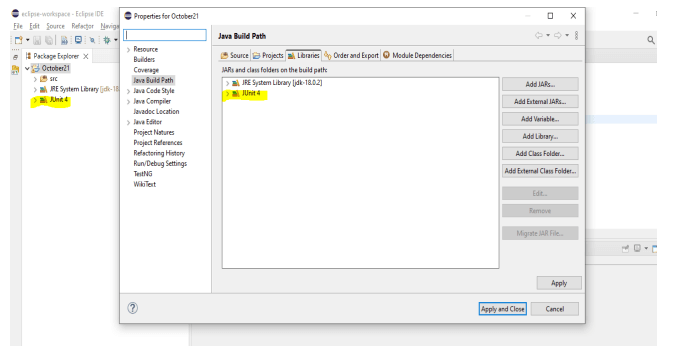Introduction to Java Testing JUnit
The following article provides an outline for Java Testing JUnit. Java tests specific elements of the source code, such as classes and the methods they provide. It is also known as junit testing and writing tests to expose whether each class and its method follows or deviates from the principle, for which each method and class has a single, obvious responsibility. It serves as a unit testing method as well as the smallest conceivable chunk of logically separated code in a system.

Key Takeaways
- The Assert class in JUnit offers static methods to test for certain circumstances.
- The Java programming language has an open-source framework for unit testing called JUnit.
- Every time new code is added, certain test cases in Java need to be run again. To make sure that the code is not broken, this is done.
- The functionality of the methods inside the classes we have created is tested using JUnit testing.
- We evaluate a method’s ability to handle exceptions in the desired manner as well as for predicted results and occasionally exception-throwing scenarios.
What is Java Testing JUnit?
Java programmers can write test cases and test their programs using one of the testing frameworks. In the most recent version, we create test cases in order to run unit tests with code to ensure that the program logic works as expected. Junit, also known as the Regression Testing Framework, is a programming framework used by developers to help them implement programs faster and with higher code quality.
It integrates easily with plugins such as eclipse, ant, and maven fixtures, test suites, test runners, and Junit classes. These are some of the features of junit test frameworks, and each set of frameworks has its own data baseline and objects for running tests in a repeatable environment.
Why do you Need Java Testing JUnit?
The behavior of the methods contained within the classes that have been created and tested using unit tests. We evaluated the method that could handle errors and exceptions in the desired manner, predict results, and occasionally throw an exception in certain scenarios. We know that in order to perform unit testing, we must first write test cases that ensure the program logic produces the expected results.
It makes it easier to find bugs in the mentioned code and more reliable in application performance, allowing developers to work in a test-driven environment. The developer is then forced to read the code, which is more readable and reliable than writing it, in order to build more confidence during the development activities. Each version of junit has similar advantages and features for implementing the application, including all of the default keywords, statements, and methods for use with parameters.
How to Set Up Java Testing JUnit?
To setup and test the java testing by using junit then we need an IDE like eclipse, intellij, etc. Here I am using eclipse ide to perform the junit testing.
Steps to create Junit program and execution:
1. Open eclipse and create a new Java project.
2. Then create the java class with the main method.
3. Here I am using a method called f() and inside of print some strings.
4. Then I am using @Test annotation for to map and execute this program into Junit.
5. Once I added the annotation it automatically added the import org.junit.Test.
6. And also added the required version jar files.
7. Execute the program by using Junit Test and we get the following output in the console screen.
Java Testing JUnit Framework
Classes used in JUnit development and testing are essential.
The following are some of the most important cases.
- Assert is a class that contains a collection of assert methods.
- TestCase, which consists of a test case that can be specified with the fixture required to execute several tests.
- TestResult is a class that contains methods for gathering test case results. Junit is an open-source unit testing framework developed by IBM programmers. Junit has been translated into other programming languages and is widely used in Java applications. Junit’s modularity is its primary advantage, which has been demonstrated with numerous software web application components by utilizing Junit’s various modules. As an alternative to testing the entire web application, we can use Junit to test a subset of classes.
Java Testing JUnit Setting
Here, we can use the Eclipse IDE and a few key actions to get Junit running on our machine. Then the aforementioned URLs to download the required JUnit jars.
By configuring the environment variables, link these jars to the system variables.
Create and configure the path in Eclipse.
We can also set up the environment variables to perform the Junit tasks.
It’s needed the below things:
- Class files for Junit
- More Java test classes
- Then the class files rely on libraries. Its all needed for jar data.
Features of Java Testing JUnit
Given below are the features mentioned:
- The open-source framework Junit is mainly used to create and execute the tests.
- It annotates the test methods with relevant information.
- It also includes claims for testing the predicted outcomes.
- It offers the test runners so that tests can be executed.
- We can also create and improve faster code changes for Junit tests.
- A set of objects will help to fix the state that will serve as a baseline for testing.
- Each test suite is a collection of unit test cases that are executed simultaneously.
- Test runners are the programs that are used to run test cases.
FAQ
Given below are the FAQs mentioned:
Q1. Define Junit testing.
Answer: An open-source unit testing framework for the Java programming language. Java developers use this framework to create and run automated tests.
Q2. Why is JUnit testing necessary?
Answer: JUnit testing is used to validate the functionality of methods within classes that we have created. And to see if the method can handle exceptions as desired for the desired outcomes and occasionally exception-throwing instances.
Q3. How should a JUnit test case be run?
Answer: Make a class for test runners. It uses the runClasses() function, which accepts the name of the test class as an argument, and imports the JUnitCore class.
Conclusion
The understanding of what unit testing is and of Junit testing then it’s observed and how Junit testing could be carried out in java. In that testing, we can also compare by using the command prompt to demonstrate what we could change in the code in the application regarding code comparison to integrate the test successfully.
Recommended Articles
This is a guide to Java Testing JUnit. Here we discuss the introduction, how to set up java testing JUnit, framework, features, and FAQ. You may also have a look at the following articles to learn more –





